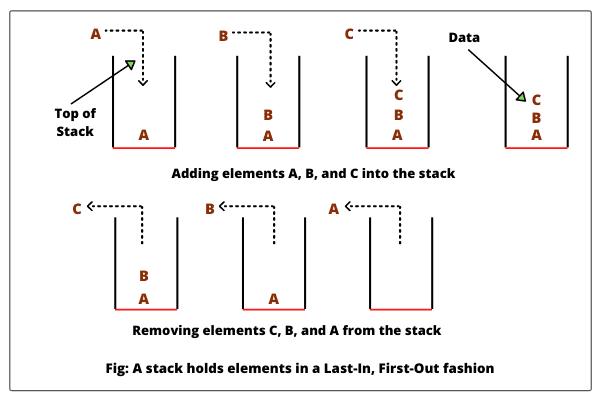Python - Stack
-
stack data strcuture allows operations at one end wich can be called top of the stack.We can add elements or remove elements only form this en dof the stack.
-
In a stack the element insreted last in sequence will come out first as we can remove only from the top of the stack. Such feature is known as Last in First Out(LIFO) feature. The operations of adding and removing the elements is known as PUSH and POP. In the following program we implement it as add and and remove functions. We declare an empty list and use the append() and pop() methods to add and remove the data elements.
PUSH into a Stack
class Stack:
def __init__(self):
self.stack = []
def add(self, dataval):
# Use list append method to add element
if dataval not in self.stack:
self.stack.append(dataval)
return True
else:
return False
# Use peek to look at the top of the stack
def peek(self):
return self.stack[-1]
AStack = Stack()
AStack.add("Mon")
AStack.add("Tue")
AStack.peek()
print(AStack.peek())
AStack.add("Wed")
AStack.add("Thu")
print(AStack.peek())
Output
Tue
Thu

POP from a Stack
As we know we can remove only the top most data element from the stack, we implement a python program which does that. The remove function in the following program returns the top most element. we check the top element by calculating the size of the stack first and then use the in-built pop() method to find out the top most element.
class Stack:
def __init__(self):
self.stack = []
def add(self, dataval):
# Use list append method to add element
if dataval not in self.stack:
self.stack.append(dataval)
return True
else:
return False
# Use list pop method to remove element
def remove(self):
if len(self.stack) <= 0:
return ("No element in the Stack")
else:
return self.stack.pop()
AStack = Stack()
AStack.add("Mon")
AStack.add("Tue")
AStack.add("Wed")
AStack.add("Thu")
print(AStack.remove())
print(AStack.remove())
Output
Thu
Wed

Python - Queue
-
The queue data structure aslo means the same where the data elements are arranged in a queue. The uniqueness of queue lies in the way items are added and removed. The items are allowed at on end but removed form the other end. So it is a First-in-First out method.
-
A queue can be implemented using python list where we can use the insert() and pop() methods to add and remove elements. Their is no insertion as data elements are always added at the end of the queue.
Adding Elements
In the below example we create a queue class where we implement the First-in-First-Out method. We use the in-built insert method for adding data elements.
class Queue:
def __init__(self):
self.queue = list()
def addtoq(self,dataval):
# Insert method to add element
if dataval not in self.queue:
self.queue.insert(0,dataval)
return True
return False
def size(self):
return len(self.queue)
TheQueue = Queue()
TheQueue.addtoq("Mon")
TheQueue.addtoq("Tue")
TheQueue.addtoq("Wed")
print(TheQueue.size())
Output
3

Removing Element
In the below example we create a queue class where we insert the data and then remove the data using the in-built pop method.
class Queue:
def __init__(self):
self.queue = list()
def addtoq(self,dataval):
# Insert method to add element
if dataval not in self.queue:
self.queue.insert(0,dataval)
return True
return False
# Pop method to remove element
def removefromq(self):
if len(self.queue)>0:
return self.queue.pop()
return ("No elements in Queue!")
TheQueue = Queue()
TheQueue.addtoq("Mon")
TheQueue.addtoq("Tue")
TheQueue.addtoq("Wed")
print(TheQueue.removefromq())
print(TheQueue.removefromq())
Output
Mon
Tue
